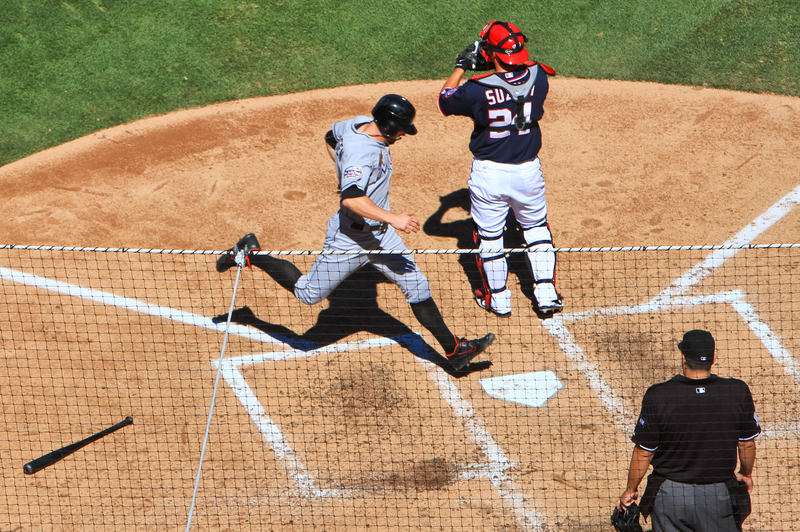Last updated on October 26th, 2023 at 07:03 am
Only the team that is up batting has the opportunity to score runs in a baseball game. Every team gets three outs to use per inning, and once you record your third out, you move to defense, or it could be the end of the game if it were the ninth inning. The pitching team can’t score any runs during a baseball match.
Baseball runs only occur when a baserunner successfully touches home plate prior to being tagged our forced out at the plate.
What are the Ways to Score a Run in a Baseball Game?
There are numerous ways to score runs during a baseball game. Here is a breakdown of scenarios that can drive in runs for your baseball team during a game.
Getting a Base Hit that Drives in a Run
Making contact with the baseball with your bat and getting to first base without the throw beating you is a clean hit. If there are baserunners on the diamond when you pick up that hit, they have a chance to score at home plate. For example, a runner on second base can usually score on a single up the middle to center field. Another instance is if a baserunner is on third base, they will easily score at home plate with a single or double to the outfield.
Hitting a Home Run in Baseball
An automatic run in baseball occurs when a batter hits the ball over the outfield fence and keeps it fair. Any player that hits a home run runs around the diamond and touches every base before touching home plate to score the run. You get an automatic RBI stat for your performance by hitting a home run.
You can also hit an inside-the-park home run, which means you scored on a hit without the ball going over the fence. Common ways that an inside-the-park home run occurs is if the hitter is fast and hits it in an area where the defenders misplay a bounce against the outfield fence. The combination of speed and ball placement can lead to an inside-the-park home run for the hitter.
Finally, any baserunner that is on base scores during a homerun automatically. For example, a runner on second base will score on a home run, which means two runs took place from the hit. A grand slam occurs when you have a baserunner on each base during a home run. A grand slam means four runs on one swing.
Walking with the Bases Loaded
A baseball hitter can drive in a run during a game by walking when the bases are loaded. Since the batter needs to go to first base on the walk from four balls, every player moves 90 feet to the next base, so the player on third comes home to score.
A Balk that Moves all Runners up 90 Feet
A balk can score a run for a team even if the bases are not loaded. For example, if a pitcher twitches or starts and stops on the mound, every baserunner moves up 90 feet. That means that if there was one runner on third base, they move to home plate, which means your team scores.
Stealing Home
Stealing home plate is a risky move in baseball. Players who attempt stealing home do so when the pitcher doesn’t give them much attention at home. They tend to have excellent baserunner speed and take off immediately towards home plate during the pitcher’s windup to the batter to attempt scoring.
Grounding into a Fielder’s Choice
Baseball hitters can ground out to an infielder and still bring home a run for their team. You need to have a baserunner on third base and one out or less in the inning to do this. The defensive squad trades a run for an out with the ground out.
However, scoring is less likely to occur if the infield is playing in. When the defense plays in, they are closer to home plate, which means they have a better chance of throwing a runner out at home. Teams tend to play the defensive in late in a game to preserve their lead or keep it a tied game.
Sacrifice Fly
A sacrifice fly in baseball occurs via a pop-in fair or foul territory deep enough to score a run. Most sacrifice flies are lazy fly balls to the outfield that a baserunner can tag up and score from third base to home. A sacrifice fly can only occur if that out in the outfield was not the third out.
Squeeze Bunt
The squeeze bunt play in baseball has the runner breaking from third to home plate, so the hitter’s job is to bunt the ball on the ground. The run should score as long as the ball goes to the grounds since a fielder won’t get the ball in time to throw out the runner at home plate.
Bringing Home a Run via an Error
Baseball teams can score a run through an error by the defense. For example, runners can attempt to score when the ball goes through a defender’s legs, on an errant throw, or even on bobble from the defender. While the run or runs won’t count as an RBI, the runs still count for the team via the game matchup.
Is there a Cap to How Many Runs You Can Score in Baseball?
There is no cap on the number of runs a professional baseball team can score. A cap occurs only if the winning run scores either in the ninth or extra innings. For example, if the home team is down by two runs and a hitter belts a three-run home run, the game ends, and the next batter doesn’t come up to bat since the game is over.
However, Little League and other amateur leagues might have a cap that one team can score during an inning or game.
Conclusion: How Does Baseball Scoring Work?
In summary, there are plenty of ways a baseball team can score runs during a game. From hitting home runs to getting scores from errors, looking at the scoresheet after a match is interesting to see what players were impactful via the game’s score. Finally, only the batting team can score runs in an inning, not the defense.
Similar Posts:
What Does the K Mean in Baseball?
How Many Innings are in Softball?
How Much Do Minor League Players Make?
Greg Kristan, owner of The Stadium Reviews, LLC and TM Blast, LLC, brings his extensive experience visiting over half of the MLB ballparks, along with numerous MLS, NHL, NBA, and NFL venues, to provide in-depth coverage on the bag policy, food options, and parking. He has also been interviewed about his experiences on several sports podcasts.









